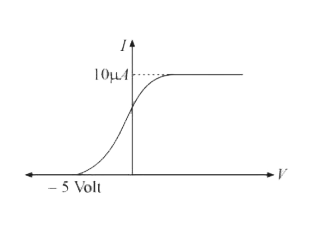In the photoelectric experiment, if we use a monochromatic light, the I-V curve is as shown. If work function of the metal is 2 eV, estimate the power of light used. (Assume efficiency of photo emission 10−3% i.e. number of photoelectrons emitted are 10−3% of number of photons incident on metal).

2W
5W
7W
10W
The correct Answer is:C
The energy of incident photons is given by hv=eVs+ϕ0=2+5=7eV
(Va is stopping potential and ϕ0 is work fumction)
Saturation current, IP=ηpehv10−5A=10−5pe7eV
P=7W
Similar Questions
In the photoelectric experiment, if we use a monochromatic light, theI–V curve is as shown. If work function of the metal is 2 eV, estimate the power of light used. (Assume efficiency of photo emission =10−3, i.e. number of photoelectrons emitted are 10−3 times of number of photons incident on metal).

View SolutionIn the photoelectric experiment, if we use a monochromatic light, theI–V curve is as shown. If work function of the metal is 2 eV, estimate the power of light used. (Assume efficiency of photo emission =10−3, i.e. number of photoelectrons emitted are 10−3 times of number of photons incident on metal).

View Solution
Knowledge Check
The work function of a metal is 2.5 eV. Light of wavelength 3600 Å is incident on this metal surface. The velocity of emitted photoelectrons will be
A3.8×106m/sB5.2×104m/sC4×104m/sD6×105m/sA light of intensity 16 mW and energy of each photon 10 eV incident on a metal plate of work function 5 eV and area 10−4m2 then find the maximum kinetic energy of emitted electrons and the number of photoelectrons emitted per second if photon efficiency is 10%.
A5 eV, 1011B10 eV, 1012C5 eV, 1013D10 eV, 1014
In the photoelectric experiment, if we use a monochromatic light, theI–V curve is as shown. If work function of the metal is 2 eV, estimate the power of light used. (Assume efficiency of photo emission =10−3, i.e. number of photoelectrons emitted are 10−3 times of number of photons incident on metal).

View SolutionIn a photoelectric experiment a parallel beam of monochromatic light with power of 200 is incident on a perfectly absorbing cathode of work function 6.25. The frequency of light is just above the threshold frequency so that the photoelectrons are emitted with negligible kinetic energy. Assume that the photoelectron emission efficiency is 100%. A potential difference of 500 is applied between the cathode and the anode. All the emitted electrons are incident normally on the anode and are absorbed. The anode experiences a force 10 due to the impact of the electrons. The value of is __________. Mass of the electron 910 and 1.01.610.
View SolutionIn a photoelectric experiment a parallel beam of monochromatic light with power of 200W is incident on a perfectly absorbing cathode of work function 6.25. The frequency of light is just above the threshold frequency so that the photoelectrons are emitted with negligible kinetic energy. Assume that the photoelectron emission efficiency is 100%. A potential difference of 500V is applied between the cathode and the anode. All the emitted electrons are incident normally on the anode and are absorbed. The anode experiences a force n×10−4N due to the impact of the electrons. The value of n is __________. Mass of the electron 9.1×10−31Kg and charge is 1.6×10−19C
View SolutionA monochromatic light of wavelength λ is incident on an isolated metalic sphere of radius a. The threshold wavelength is λ0 which is larger then λ. Find the number of photoelectrons emitted before the emission of photo electrons stops.
View SolutionA photon of wavelenth 3000 A strikes a metal surface, the work function of the metal being 2.20eV. Calculate (i) the energy of the photon in eV(ii) the kinetic energy of the emitted photo electron and (iii) the velocity of the photo electron.
View SolutionA photon of wavelenth 3000 A strikes a metal surface, the work function of the metal being 2.20eV. Calculate (i) the energy of the photon in eV(ii) the kinetic energy of the emitted photo electron and (iii) the velocity of the photo electron.
View Solution
